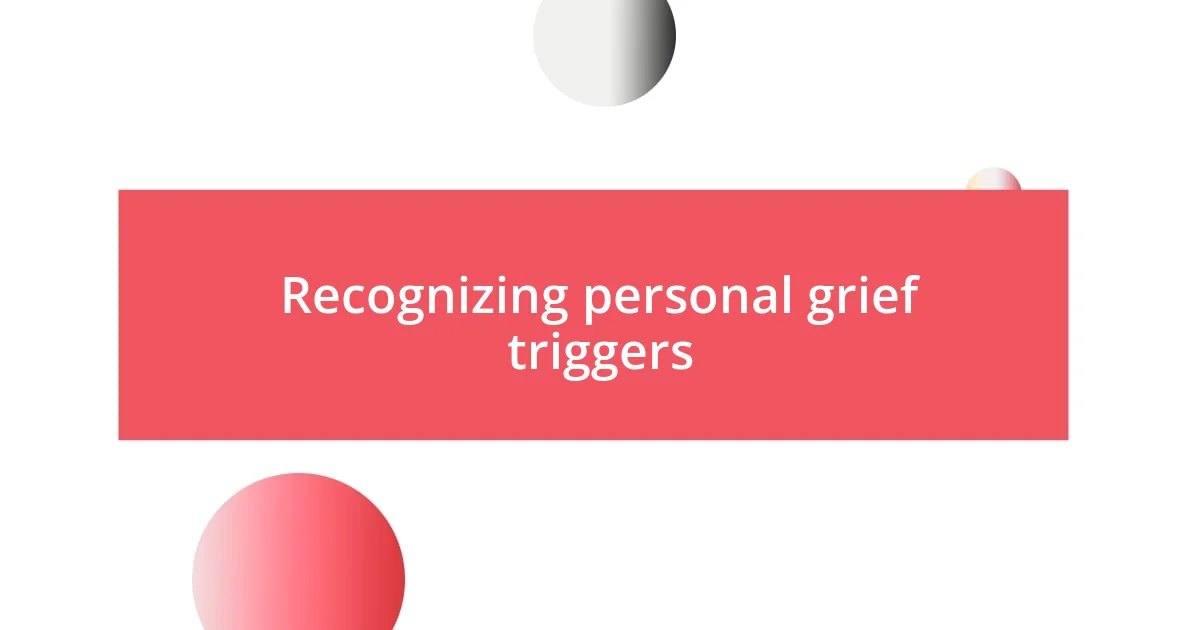Key takeaways:
- Grief is a non-linear, complex emotional journey that encompasses a range of feelings including sadness, anger, and moments of joy.
- Recognizing personal triggers—sensory, environmental, and temporal—can aid in processing grief and transforming sorrow into celebration.
- Building a supportive network and seeking professional help are crucial steps that foster healing and understanding during the grieving process.

Understanding the nature of grief
Grief is often a complex tapestry of emotions, weaving together sadness, anger, confusion, and even moments of relief. I remember a time when a wave of anger hit me while cleaning out my late grandmother’s closet. Was I angry at her for leaving or at myself for not being able to save her? These conflicting feelings can be so overwhelming, yet they are a natural part of our response to loss.
One thing I’ve learned is that grief is not linear. Some days feel manageable, while others can sneak up on you, pulling you back into the depths of sorrow. I’ll never forget how a song played on the radio one afternoon brought me right back to my childhood, flooding my heart with memories that both comforted and pained me. How can joy and sadness coexist so starkly? It’s in these moments that we truly discover the intricacies of our emotions.
Additionally, I’ve found that understanding grief requires embracing its unpredictability. After the loss of my father, I often struggled with guilt—why was I laughing with friends when I should be mourning? This internal conflict opened my eyes to the idea that grief doesn’t always mean suffering; it can also be healing and restorative. These reflections help me appreciate that grief is a deeply personal journey, uniquely crafted by our relationships and experiences.

Recognizing personal grief triggers
Recognizing personal grief triggers is an essential part of navigating this complex journey. For me, the smell of freshly baked cookies often brings a rush of memories from family gatherings at my childhood home. It’s remarkable how something as simple as a scent can transport us back to moments filled with love and loss. It made me realize that triggers can be both comforting and painful.
I also discovered that certain places can evoke deep feelings of grief. I remember visiting my favorite park where I spent time with my late friend. The laughter we shared echoed in my mind as the tranquility of the surroundings was disrupted by a sudden wave of sadness. In those instances, it’s vital to recognize how our environment can influence our emotional state and how being aware of these triggers can help us process our feelings.
Moreover, I learned that specific dates hold significant emotional weight. The anniversary of my father’s passing always brings a flood of mixed emotions. Sometimes, planning a small remembrance can transform that sorrow into a celebration of his life, reminding me of the good times we had. Understanding these personal grief triggers is crucial; it empowers us to face and process our emotions more effectively.
| Type of Trigger | Example from Personal Experience |
|---|---|
| Sensory | The smell of cookies sparking memories of family gatherings |
| Environmental | Visiting a favorite park where I shared moments with a late friend |
| Temporal | Anniversary of my father’s passing and planning remembrance |

Exploring various grieving processes
Grieving is a deeply individual process, and I’ve discovered that it can manifest in various forms. Some people, like my friend who lost her mother, find solace in keeping busy, channeling their grief into work or volunteer activities. Others, such as myself, may need solitude to reflect and process emotions. I remember sitting quietly by a river, allowing nature to absorb my tears as I tried to untangle the complexities of my feelings. Each approach can be valid, highlighting how there’s no one right way to grieve.
Here are some distinct grieving processes that resonate with many:
- Avoidance: Some may distance themselves from feelings or memories to cope with the pain, similar to how I once kept old photographs tucked away until I felt ready to confront them.
- Active Mourning: Others might engage in rituals like creating a memory box or holding memorial gatherings, helping to foster connection with their loved ones. I recall lighting candles every year on my grandmother’s birthday, sharing stories with family to celebrate her life.
- Creative Expression: For some, art, writing, or music becomes a powerful outlet. I found painting surprisingly cathartic, as each brushstroke allowed me to express emotions I couldn’t articulate in words.
- Joint Mourning: Many people benefit from sharing their journey with others, whether through grief support groups or open conversations with friends, which can lead to unexpected healing and understanding. I remember a candid talk with a close friend about our shared losses, which left me feeling lighter and more connected.
Understanding these varied grieving processes broadens our perception of grief, making it easier to embrace our own path while respecting the journeys of others.

Finding healthy coping mechanisms
Finding healthy coping mechanisms can be a lifeline during grief. One method I found particularly effective was journaling. As I sat with my notebook, pouring out my thoughts and emotions, it felt like a weight was being lifted. It made me ask, have you tried putting your feelings into words? The act of writing became a safe space for me to explore my grief, allowing me to articulate feelings that seemed too overwhelming to face directly.
I also discovered the power of physical activity as a coping mechanism. There were days when all I needed was a brisk walk to clear my mind. At first, it felt challenging to even begin, but once I stepped outside, I found a sense of calm in the rhythm of my footsteps. Have you ever noticed how nature can soothe the soul? I recall walking through a quiet trail, the gentle sounds of chirping birds reminding me that life continues, even when we’re in the depths of sorrow.
Lastly, connecting with others proved to be invaluable. During my lowest moments, reaching out to friends or joining a support group created a shared understanding that made my grief feel less isolating. I remember sitting in a circle, sharing stories with strangers who quickly became like family. It made me realize that in our pain, we can find community. Have you considered who you can lean on during tough times? Sometimes, just knowing someone else understands can bring a sense of peace.

Seeking professional help options
Seeking professional help can feel daunting, but it’s a crucial step in navigating grief. When I decided to reach out to a therapist, it felt like breathing fresh air after being submerged underwater. They opened up new perspectives I hadn’t considered, helping me understand that grief isn’t just a feeling to endure but a complex journey that deserves exploration. Have you thought about how professional support could illuminate your path?
Counseling offers a safe space to express emotions without judgment. I vividly remember sitting in my therapist’s office, feeling both vulnerable and safe as I cried about my loss. It struck me how valuable it was to articulate feelings that I had bottled up for so long. Just having someone genuinely listen and guide me through my grief allowed me to process it differently. Can you recall a time when sharing your thoughts brought relief?
There are also various approaches within professional help, like group therapy or online support. I once attended a grief group that brought together people from different walks of life, each carrying their own stories. The shared experiences were profound; it illuminated how diverse grief can be. I realized that we weren’t alone in our pain, and those connections fostered an unexpected healing. Have you considered what unique benefits these group settings might offer?

Building a support network
Building a support network is essential as we navigate the rough waters of grief. I remember reaching out to close friends and family during my hardest days, and it was like holding onto a lifeline. Have you thought about who in your life can provide that comforting presence? Sometimes, just having someone sit with you in silence can speak volumes.
Joining local support groups gave me the chance to meet others with shared experiences. The first time I walked into that room, I felt a mix of apprehension and hope. As I listened to others share their stories, I couldn’t help but feel a sense of camaraderie. In those moments, I understood that grief isn’t a solitary journey; there’s strength in numbers. Have you found spaces where you can connect with others who truly get it?
Moreover, I learned to lean on online communities, especially when in-person connections felt exhausting. Chatting with fellow grievers over a messaging app became a comforting ritual for me, offering support that transcended geographical boundaries. I recall a night spent typing out my feelings to a stranger who responded with just the right reassurance I needed. Isn’t it fascinating how the digital world can bring us together in our darkest moments? Building a diverse support network has been transformative for me, reminding me that even in grief, we’re never completely alone.

Embracing healing and growth
Embracing healing has taught me that it often comes in waves, sometimes crashing unexpectedly. I recall a particularly tough day when I stumbled upon an old photo album. As I flipped through the pages, nostalgia washed over me and tears flowed freely. Yet, amidst my sorrow, I felt a shift—each memory felt like a step in a dance toward acceptance. Have you allowed yourself the grace to feel deeply while also cherishing what was?
Growth in grief requires patience, often revealing lessons that shape our perspective on life. After several months of reflection, I began to notice subtle changes in how I approached my daily routines. Small joys, like sipping my morning coffee while watching the sunrise, began to take on renewed significance. It’s remarkable how embracing these little moments can gradually lead to a fuller life after loss. Have you observed how the world’s beauty persists even during your darkest times?
Engaging in creative outlets became a crucial part of my healing journey. I picked up painting, which allowed me to express feelings that were difficult to articulate. I remember one session, where splatters of color mirrored my chaotic emotions; what started as anger transformed into a landscape of hope. This process taught me that healing isn’t linear, and it’s okay to embrace the messy complexity of our feelings. What creative avenues might you explore in your journey toward healing?















